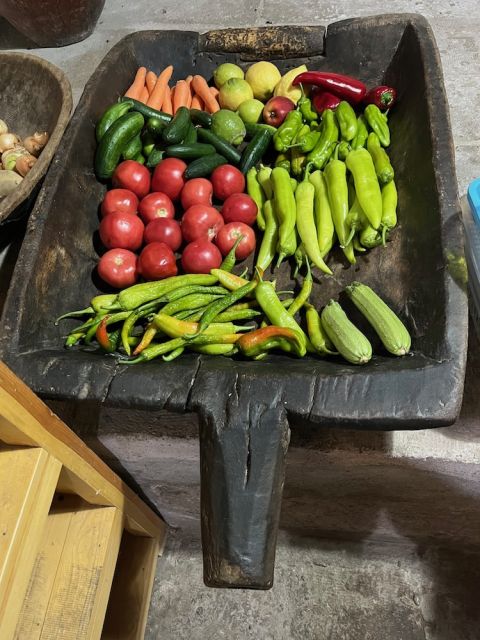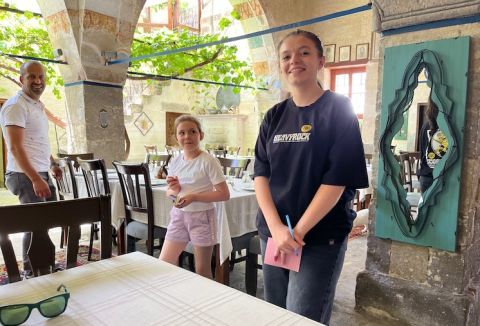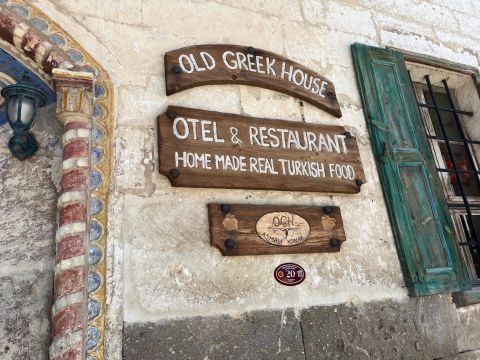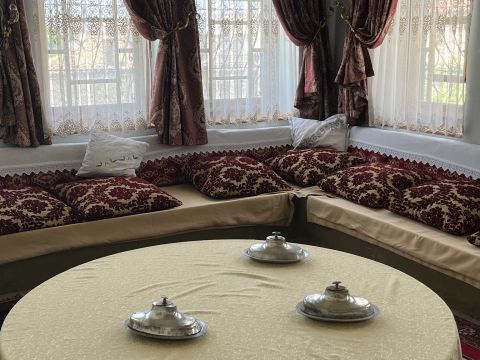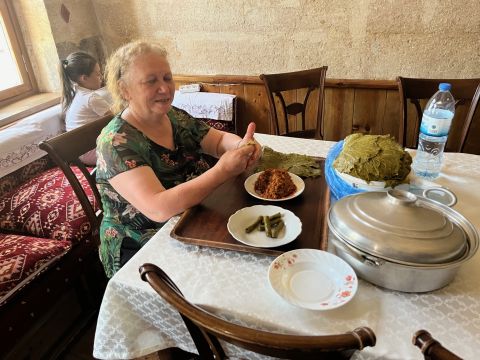Eating out in Istanbul and Cappadocia

How can modern cuisine compete with the traditional fare of the old Ottoman empire?
I recently spent a week in Corfu, Greece, followed by five nights in Istanbul and Cappadocia/Kapadokya in Türkiye. In both countries I ate and drank well, but I was left with a sense of sympathy for both these countries’ young, aspiring chefs aiming to create a new identity for their country’s cooking styles.
This feeling begins with their history. Türkiye saw the inception of modern farming and agriculture. The countryside produces everything in abundance: tomatoes, cucumbers, peppers, aubergines, onions, courgettes. You name any vegetable or salad and Türkiye, and to a lesser extent Greece, is a major producer – of nuts, raisins and all types of fruit as well. And of olives and therefore of olive oil, and of a diet which many associate with longevity in all those who can enjoy it. Certain meats they seem to have in plenty and many species of fish in abundance.
Over the centuries their chefs have used these riches in a fascinating array of dishes. Both countries are proud of their tradition of mezes, the abundance of first courses, but I wondered why? Was it the opportunity to show off the dexterity of the kitchen staff? Or because Greeks and Turks, in an attempt to avoid any argument or to minimise any decision-making, decided to let the kitchen show off and to leave it up to the customer to decide exactly what they chose to eat?
Whatever the ultimate cause, the quality level of mezes has been set, and set high, and it is for future chefs to exceed this. How, though, any chef, however talented, can exceed the bounty of a Turkish breakfast is beyond me, as these photographs of what is on offer at breakfast in the Argos in Cappadocia hotel shows only too well. Here there is everything that you could possibly think of to start the day, supplemented by a menu of a dozen hot dishes, including porridge for the very hungry (or those recovering from an early-morning balloon ride). Who could conjure up a better, more comprehensive, more copious start to any day?
And lunches and dinners provide a challenge, too. My most memorable meal in either country – at the aptly named Old Greek House in Mustafapaşa in Cappadocia – began with mezes, cacik, gözleme and, most unforgettably of all, with their vine leaves stuffed with rice cooked in tomatoes and seasoned with dill, mint, parsley, coriander and lemon juice. They came with an introduction to their maker, a female chef and a grandmother.
It is the produce that defines the cooking as much as history. The Ottomans ruled for several centuries and enjoyed their food. The records from the imperial kitchens in Istanbul reveal this as they were the only kitchens capable of feeding Istanbul’s population when the enemy threatened to cut off the city from the farmers outside the city walls. But the history that led to so many excellent, easy, healthy recipes presents challenges for even the most technically efficient young chef.
Certainly, that was my experience at two of our dinners in Türkiye, at Neolokal in Istanbul and Nahita in Argos in Cappadocia. The former is located in a building that once housed the Ottoman Bank but has been completely redesigned to reveal a massive open kitchen on the first floor and a restaurant on the second that is reached by a steep set of stairs that must obviate the need for a gym for all the waiting staff. An outdoor terrace offers the most glorious views of this city.
But the view proved the evening’s most satisfactory ingredient. The chef here, and at Nahita which astutely focuses on ingredients grown within a 60-km radius of the restaurant (in which the most significant Neolithic Age settlements are to be found), are obviously talented and their brigades skilful but the dishes I ate lacked the freshness of the more traditional restaurants. They were trying too hard. At Neolokal the inclusion of an iPad, headphones and a five-minute video explaining the mushroom course in the tasting menu seemed an affectation and unnecessary interruption, and the sorbet course – in 2024 – an anachronism. (‘No sorbet’ ought to be the rule today as per the diktat of the late Len Evans.)
The traditional meal that exemplified the high standards that today’s young chefs must equal, if not surpass, also exemplified the close and invariably sad history that links these two countries and their peoples.
The Old Greek House in Mustafapaşa, a small village (population just over 1,250) five km south of Ürgüp in Cappdocia was just that, an old Greek house. Until 1924 it was the home of a wealthy Greek family. After they had been forced to leave during the notorious ‘population exchange’, it became the property of the Turkish Treasury before being taken over in the 1990s by the Ozturk family. Today, two brothers, both grandfathers, walk the tables and man the reception. One of their sons manages the restaurant while his two daughters take the orders. It is very much a family affair.
The two-storey building, with outdoor seating, is charming and welcoming but it is the interior which captured my imagination. Through atmospheric painted arches it is open to the heavens which allows dappled sunlight into the room. The trees planted in this open form a leafy bower along one wall.
It is engaging and calming, a location that could be in either Greece or Türkiye, a fact acknowledged by the sign outside, seen below.
We ordered – or rather my guide did, as this is his favourite restaurant – just before a group of 40 Greeks walked in. We began with cacik, a combination of yoghurt, cucumbers and garlic like tzatziki; a plate of cheese gözleme; and two of the dishes the restaurant has become famous for. The first is the aforementioned rice-stuffed vine leaves; the other is hünkar beğendi (which translates as ‘the sultan liked it’), a dish created several centuries ago to which the sultan gave his name. The lamb stew is topped with roasted aubergine to which melted cheese has been added. It’s easy to see why its popular name is sultan’s delight.
I wandered upstairs and walked around a set of rooms that do not seem to have changed that much from the early 20th century. When one of the grandfathers noticed my curiosity, he beckoned me into a room just off the restaurant on the ground floor where I was initially greeted by a small yapping dog. While the younger of the two granddaughters quietened it in the corner, I was introduced to her grandmother who is in charge of rolling and stuffing the vine leaves.
In front of her was a mound of steamed vine leaves (the family keeps a vineyard to ensure a constant and consistent supply), a dish of the cooked, spiced tomato rice and a dish of the finished, rolled vine leaves. We talked via our guide. She explained to me what she was doing and that it will take her most of the afternoon to finish this mound of vine leaves. She wanted to make clear quite how happy she was to be doing this job, knowing that it will bring a great deal of happiness to her customers. Conscious of how sticky her hands must be, I squeezed her arm and said goodbye.
I paid my bill, 1,560 Turkish lira or just under £40 for the three of us, and we left. I had enjoyed a remarkably good meal in an exceptional setting – certainly one of my most memorable meals ever. And as I left, I wondered – which young Turkish chef will ever be able to deliver more?
Argos in Cappadocia Tekelli, Kayabaş Sk 23, 50240 Uçhisar/Nevşehir Merkez/Nevşehir; tel: +90 384 219 3130
Neolokal Arap Cami, Mahı, Bankalar Cd 11, 34420 Beyoğlu/İstanbul; tel:+90 551 447 4545
Old Greek House Davutlu, Şahin Cd 12, 50420 Mustafapaşa/Ürgüp/Nevşehir; tel: +90 384 353 53 06
Every Sunday, Nick writes about restaurants. To stay abreast of his reviews, sign up for our weekly newsletter.
Become a member to view this article and thousands more!
- 15,409 featured articles
- 275,024 wine reviews
- Maps from The World Atlas of Wine, 8th edition (RRP £50)
- The Oxford Companion to Wine, 5th edition (RRP £50)
- Members’ forum
- 15,409 featured articles
- 275,024 wine reviews
- Maps from The World Atlas of Wine, 8th edition (RRP £50)
- The Oxford Companion to Wine, 5th edition (RRP £50)
- Members’ forum
- 48-hour preview of all scheduled articles
- Commercial use of our wine reviews

